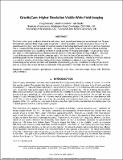GravityCam : wide-field, high-resolution imaging and high-speed photometry instrument
Abstract
The limits to the angular resolution achievable with conventional ground-based telescopes are unchanged over 70 years. Atmospheric turbulence limits image quality to typically ∼1 arcsec in practice. We have developed a new concept of ground-based imaging instrument called GravityCam capable of delivering significantly sharper images from the ground than is normally possible without adaptive optics. The acquisition of visible images at high speed without significant noise penalty has been made possible by advances in optical and near IR imaging technologies. Images are recorded at high speed and then aligned before combination and can yield a 3-5 fold improvement in image resolution. Very wide survey fields are possible with widefield telescope optics. We describe GravityCam and detail its application to accelerate greatly the rate of detection of Earth size planets by gravitational microlensing. GravityCam will also improve substantially the quality of weak shear studies of dark matter distribution in distant clusters of galaxies. The microlensing survey will also provide a vast dataset for asteroseismology studies. In addition, GravityCam promises to generate a unique data set that will help us understand of the population of the Kuiper belt and possibly the Oort cloud.
Citation
Mackay , C , Dominik , M & Steele , I 2016 , GravityCam : wide-field, high-resolution imaging and high-speed photometry instrument . in C J Evans , L Simard & H Takami (eds) , Ground-Based and Airborne Instrumentation for Astronomy VI . , 99083L , Proceedings of SPIE , vol. 9908 , SPIE , Ground-Based and Airborne Instrumentation for Astronomy VI , Edinburgh , United Kingdom , 26/06/16 . https://doi.org/10.1117/12.2230901 conference
Publication
Ground-Based and Airborne Instrumentation for Astronomy VI
ISSN
0277-786XType
Conference item
Collections
Items in the St Andrews Research Repository are protected by copyright, with all rights reserved, unless otherwise indicated.

